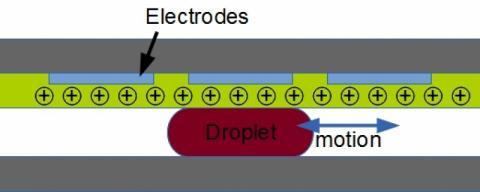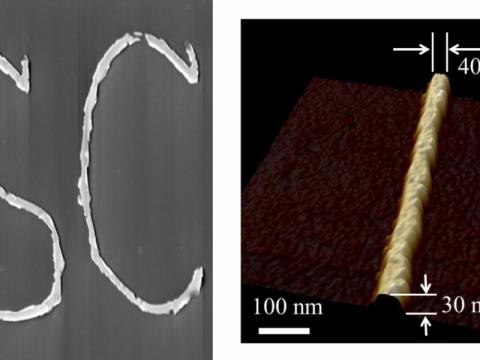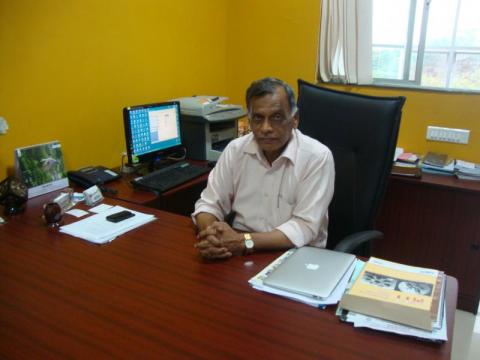 |
Powering Electronic Devices Through a Mercury Droplet Researchers at the Indian Institute of Science (IISc) have designed a new type of energy harvester that can scavenge electrical energy from weak vibrations. Vibration drives a liquid droplet and the motion of the liquid droplet produces electrical energy which can power portable electronic devices efficiently. Conventional sources of energy are precious and they are getting exhausted at a very rapid pace. Scientists are looking for alternative sources of energy, like solar energy, wind energy, energy from bio waste etc., to replace the conventional sources. “Energy harvesting” is the conversion of unusual forms of energy, like heat, wind, vibration etc., which are otherwise wasted, into some usable form of energy. Efficient energy harvesting is the key to addressing our ever-increasing energy problem. |
|
A low cost, low power soil moisture sensor Researchers at the Indian Institute of Science, Bangalore in collaboration with IIT Bombay, have come up with a low cost, low power soil moisture sensor that can accurately determine the water content of soil. Soil moisture plays a critical role in maintaining the overall balance of the Earth. It directly influences long-term climatic conditions like hydrological process and drought development. On much shorter time scales, it acts as a carrier of nutrients to plant's roots, and helps sustain life on Earth. In fact, in 2010, soil moisture was recognised as an Essential Climate Variable. |
|
|
Lab Story: Imitating nature’s nano-machines: Optics, Nanostructures and Quantum fluids Lab In 1959, physicist Richard Feynman, in his talk “There’s plenty of room at the bottom”, envisioned a future where we could engineer materials and devices from bottom up, by directly manipulating individual atoms. This field is now known as Nanotechnology. It involves developing devices and materials on a nanoscale, which is a just a billionth of a metre, a concept that nature seems to have perfected. |
|
|
This Ultralight Foam Might Save Your Life Nitrogen dioxide is toxic to humans when inhaled. Unfortunately, our noses get anaesthetised when exposed to low levels of nitrogen dioxide. This prevents us from sensing the otherwise acrid gas, creating a possibility for overexposure with harmful effects on health. This may lead to poisoning of the lung, which in some cases might prove to be fatal. Nitrogen dioxide is a reddish-brown gas found where fossil fuels are utilised as an energy source. The elevated temperatures during combustion cause the nitrogen in the atmosphere to react with oxygen to form nitrogen dioxide. Since we use fossil fuels every single day, nitrogen dioxide detectors are vital for monitoring the levels of the gas in the ambient air. |
|
 |
A path-breaking innovation ‘etched in stone’ Inside every smart device you use, there are components that used to be bigger just a few years ago. Crucial to the speed and utility of your smartphone or tab is a tiny chip made of different semiconductor materials, onto which tens of thousands of circuits are etched using rather complex methods. A new path-breaking innovation will change how this 'circuit-world' is built. A team from the Indian Institute of Science has developed a method that could be a game-changer in the semiconductor industry. It will mean faster, cheaper, more efficient patterning of nano-sized circuits at room temperature and ambient conditions; and it does not require chemicals that can harm the environment. |
|
An antibacterial water purification membrane resistant to slime Scientists at IISc have designed a membrane which can remove bacterial contamination from water, while at the same time preventing biofouling, or the accumulation of micro-organisms on the membrane. |
|
|
Technology transfers from a lab in CeNSE, IISc Designing the world’s smallest speakers that are inspired by the chirping of crickets, writing some of the tiniest metal patterns in a frugal way and mechanically detecting cancer in living cells are some of the most exciting technology transfers brewing from one lab in the Centre for Nanoscience and Technology, Indian Institute of Science. |
|
|
A REACTOR TO PRODUCE GRAPHENE, MADE IN INDIA Indian Institute of Science and KAS Tech have together developed India's first commercially available, graphene producing system. The Centre for Nano Science and Engineering (CeNSE), IISc developed the technology, and working together with KAS Tech, a Bengaluru based manufacturing company, they transformed the lab prototype into a commercial product. The product was launched during the recently held Bangalore INDIA NANO. |
|
|
SCIENTISTS USE A SWEETENER TO MAKE MATERIALS FOR BONE RECONSTRUCTION A team of researchers from the Indian Institute of Science, Bangalore, has developed a novel polymer that can accelerate healing of bone fractures. Dr. Kaushik Chatterjee, Assistant Professor in the Department of Materials Engineering in collaboration with Professor Giridhar Madras from Chemical Engineering at IISc are working on developing polymers that can serve as templates to facilitate bone growth. The team is working on developing maltitol-based biodegradable polyesters for accelerated healing. |
|
 |
On aircraft display systems, microsensors and scientific networking Last week, on the 20th of August, Prof S Mohan received the Academy Excellence Award from Prime Minister Shri Narendra Modi at a function organized by the Defence Research Development Organisation (DRDO) in New Delhi. The award is a fitting recognition for his sustained contributions to innovative technologies for a variety of applications at the DRDO, from display systems in combat aircrafts to micro sensors deployed on defence personnel. We decided to talk to him about his three decade long involvement with the mammoth organization. |